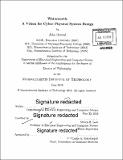| dc.contributor.advisor | Steven B. Leeb. | en_US |
| dc.contributor.author | Donnal, John Sebastian | en_US |
| dc.contributor.other | Massachusetts Institute of Technology. Department of Electrical Engineering and Computer Science. | en_US |
| dc.date.accessioned | 2016-12-22T16:28:07Z | |
| dc.date.available | 2016-12-22T16:28:07Z | |
| dc.date.copyright | 2016 | en_US |
| dc.date.issued | 2016 | en_US |
| dc.identifier.uri | http://hdl.handle.net/1721.1/106079 | |
| dc.description | Thesis: Ph. D., Massachusetts Institute of Technology, Department of Electrical Engineering and Computer Science, 2016. | en_US |
| dc.description | Cataloged from PDF version of thesis. | en_US |
| dc.description | Includes bibliographical references (pages 347-355). | en_US |
| dc.description.abstract | The combination of powerful and inexpensive embedded computers, advanced sensor technology, and high speed wireless networks could revolutionize how we interact with our physical environment. Sensor networks that provide real time feedback offer significant value in terms of energy reduction, fault detection, equipment diagnostics, monitoring, security and more. This revolution will not happen in a positive way without a clear vision of how sensor, network, and control technologies can be applied to enhance human abilities and improve our lives. Such systems have been frustratingly difficult to implement. An old dilemma is becoming increasingly apparent. Networking provides remote access to information and control inputs. Gathering useful information, however, may require the installation of an expensive and intrusive array of sensors. Without this array, networked control provides colorful but minimally useful real information. Technological marvels like solid-state or micro-electromechanical sensors may ultimately reduce the cost of individual sensors through mass-production. They may not, however, reduce installation expense. They also do nothing to recover waste of resources. Even with the array, it may be difficult for a facilities operator to make informed control and maintenance decisions that intelligently affect mission critical components. Large datasets remain difficult to use. This thesis presents a design approach for creating cyber physical infrastructure that addresses these challenges to delivering actionable real time feedback. At the core of the system is a suite of non-intrusive sensors that dramatically reduce the cost of data acquisition. These sensors process and store data locally, without any dependency on external servers. This removes the security and privacy concerns that plague conventional sensor networks. A decentralized cloud infrastructure securely connects users to sensor platforms and provides powerful visualization and programming interfaces to customize data presentation. This works covers the complete system design from embedded analog sensors to enterprise grade backend server architecture, to the frontend human computer interface. Such a wholistic design approach is critical to ensure a cyber physical system delivers quantifiable value to the end user. Several case studies illustrate the success of this design approach, including an automatic watch stander system for the US Coast Guard, an energy monitoring platform for a US Army Base, and realtime equipment diagnostic platforms installed in a wide variety of environments including an Army hospital and a local elementary school. | en_US |
| dc.description.statementofresponsibility | by John Donnal. | en_US |
| dc.format.extent | 355 pages | en_US |
| dc.language.iso | eng | en_US |
| dc.publisher | Massachusetts Institute of Technology | en_US |
| dc.rights | M.I.T. theses are protected by copyright. They may be viewed from this source for any purpose, but reproduction or distribution in any format is prohibited without written permission. See provided URL for inquiries about permission. | en_US |
| dc.rights.uri | http://dspace.mit.edu/handle/1721.1/7582 | en_US |
| dc.subject | Electrical Engineering and Computer Science. | en_US |
| dc.title | Wattsworth : a vision for cyber physical system design | en_US |
| dc.type | Thesis | en_US |
| dc.description.degree | Ph. D. | en_US |
| dc.contributor.department | Massachusetts Institute of Technology. Department of Electrical Engineering and Computer Science | |
| dc.identifier.oclc | 965199240 | en_US |
